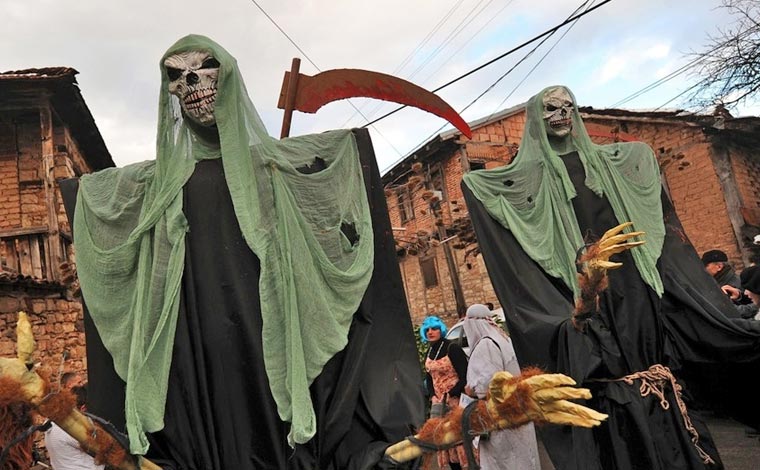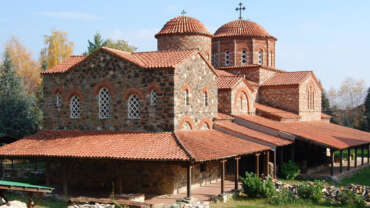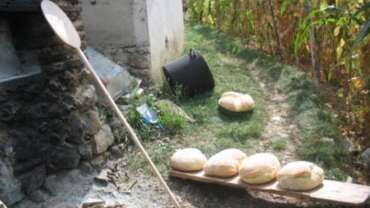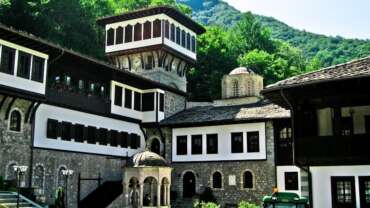Experiences in Macedonia
Macedonian Folklore
Always closely connected with their motherland, the Macedonians lived with centuries with the tradition they passed over from generation to generation and thus creating new, rare and unusual substantial and spiritual culture with patriarhic features. From their extensive cultural heritage, the Macedonian creators of impressive folklore poetry and music preserved significant cultural heritage even today – Macedonian folklore art.
It developed on the basis of Old-Slavic and Balkan art as well as on the basis of the various elements from the other peoples, especially Byzatine and Turkey. Although Macedonian folklore embraces exotic elements, it still developed independently and uniquely transforming itself according to its taste and changing it into its indivisible part.
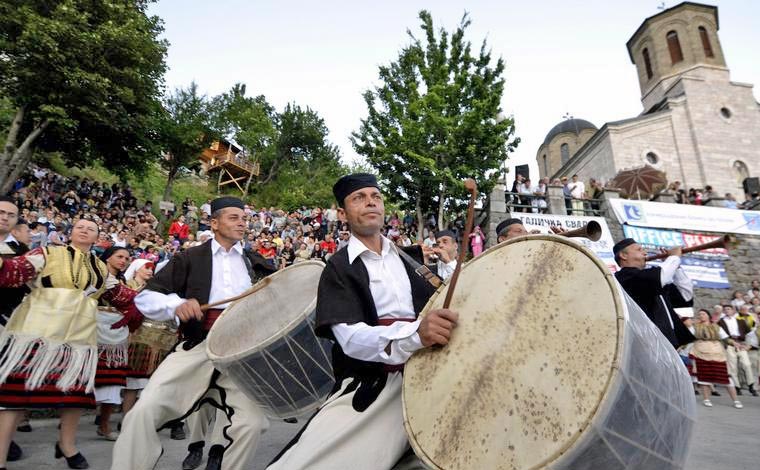
MACEDONIA ENTERTAINMENT – MACEDONIA LIFESTYLE
Vevcani Carnival
The carnival itself is actually a tradition under masks, which is called Sveti Vasilja (Vasilica). It is held on the 13th and 14th of Januar yeach year and is dedicated to St. Vasilius The Great. On that day the arrival of the New (orthodox) Year is awaited and the old year is sent away. This is actually a pagan tradition which is preserved here until today. The participants in it are called “vasilicari”. The masks can be traditional or of modern day.
In these two days, the people of Vevcani enjoy the magic and the mystic of the ceremony. Transformed into another character, through songs and dances they fulfil their wishes which they want in real life-to be happy and joyful.
Strumica Carnival
The Strumica Carnival is one of the most important custom and tradition of such kind in the Republic. The Strumica Carnival is traditionally held each year within the Trimeri days. The beginning of the fast or the first three days are called “Trimeri” days and they always begin on Sunday Eve of Forgiveness and last until Wednesday, within these days that is to say on Tuesday is the traditional carnival night, when masked groups stroll through the town and got to the homes where there are engaged girls and stay until the early morning hours.
Tikves Grape Picking
A festival that officially began in 1964. Held to mark the beginning of the wine grape harvest as well as commemorating the liberation of Kavadarci. It takes place over several days (beginning of September) and is one the largest cultural manifestations of its kind in the Tikves region.
The festival includes folk, pop and rock concerts, traditional dancing, seminars, presentations and exhibitions. This culminates in a carnival procession through the main streets of Kavadarci.
MakFest
Shtip boasts the largest festival of contemporary music in Republic of Macedonia called MakFest. It is held every November in the Cultural Center “Aco sopov” for over two decades.
Ohrid Summer Festival
The festival has been held annually from July 12th to August 20th, since 1961. A member of the European Festivals Association since 1994, and is regarded as one of the most prestigious international events of its kind. The Festival programme has focussed on classical music, ballet, opera and theatre. In recent years, the Festival has also opened its doors to alternative works and performances, keeping abreast of contemporary European and international cultural developments. Takes place at the ancient Ohrid theatre (capacity more than 4,000 seats).
Skopje Jazz Festival
Leading music event in the Republic of Macedonia with a remarkable tradition and an excellent reputation in Europe and around the world. It is regarded as one of the best jazz festivals in Europe. The event was established in 1982 by a group of jazz enthusiasts from Skopje. The festival is held every year in the third week of October, over five or six consecutive days. The programmes have included performances of all jazz styles.
Beer Fest
An international beer and grill festival. The festival takes place on the streets of Prilep, usually in the beginning of July. Many renowned beer producers from the Balkans and beyond participate in this event. Sausages and burgers, endless streams of beer, and great music to everyone’s taste contribute to the merry atmosphere of this three-day festival.
Galicnik Wedding
Held on 12th July every year and has a century-old tradition. This is an event to commemorate the traditional wedding customs and pay tribute to the Macedonian cultural heritage. The bride and the groom, as well as the wedding guests, are adorned in the beautiful Galicnik folk costumes, famous for being one of the most luxuriously ornamented, as compared with other folk costumes in Macedonia, or even the Balkans. The wedding takes place in the village church of St. Peter and Paul.

MACEDONIA LANDMARKS
Macedonian mountains
“Macedonia is a country of lakes and mountains, as we have mentioned before. It remains one of Europe’s last great undiscovered countries: a natural paradise of mountains, lakes and rivers, where life moves to a different rhythm”.
Macedonia’s terrain is mostly rugged, located between the Sar and Osogovo mountains, which frame the valley of the Vardar river. Macedonia is a predominantly mountainous country. Macedonia’s high mountains are suitable for winter sports and hunting. About 35% of the former Yugoslavia’s ski slopes could be found in Macedonia.
National Parks in Macedonia
– Galicica (Galicica mountain)
– Mavrovo (Bistra, Korab, Desat mountains)
– Pelister (Baba mountain)
Macedonia Ski Resorts
– Kozhuf (Kozuf mountain)
– Pelister (Baba mountain)
– Popova Sapka (Sar mountain)
– Zare Lazarevski, Mavrovo (Bistra mountain)
– Krushevo (Busava mountain)
Macedonian Lakes
Ohrid lake
The Ohrid lake is considered to be one of the oldest lakes and biotopes in the world, preserving a unique aquatic ecosystem with more than 200 endemic species that is of worldwide importance. Located in south-western Macedonia, a region with great historical and cultural value the Ohrid lake and the region have great importance (World Heritage site by UNESCO in 1979). It is primary destination for tourists during the entire year.
Prespa lake
The Prespa lake is the only one on the Balkan Peninsula to have island. The five: Golem Grad, Mal Grad, Pirg, Agios Achillaeos and Vidrinec, are located in the three countries that share the lakes today, Macedonia, Albania and Greece. With its irregular coastline, plethora of bays, extraordinary cleanliness of water, pristine nature, and setting between three national parks, Prespa is truly a place one must visit. Between the two lies the Galicica Mountain, through which flows an underground stream named Zavir, through which Prespa lake supplies Lake Ohrid with water.
Dojran lake
The Dojran lake is on the south east part of Macedonia, with surface of 43.1 sq km and max depth of 10 meters. Fishing on the lake is done in a primeval way with the help of birds, that by their presense make the fish go into the special bounds of cane called “mandri” from which the fish can not escape.
Tikves lake
The Tikves lake is the largest artificial lake in the Republic of Macedonia, it is located 165 meters above sea level, 12 km southwest of Kavadarci on the Reka Crna, and 3 km from the village of Vozarci. It is a site for sports and recreation as well as being a popular tourist attraction due to the cultural monuments and rich flora and fauna of the area.
Mavrovo lake
The Mavrovo lake is located in the Mavrovo region in north-western Macedonia. Abundant with the famous trout, Lake Mavrovo also makes for an excellent swimming, boating and fishing spot in the summer months. An additional point of interest is the half-submerged church in the lake.
Kozjak lake
The Kozjak lake is situated in the mountains south-eastern of Skopje, in the Makedonski Brod municipality (Porece region). Because of the lake, re region has became a popular destination for the tourists.
MACEDONIAN CUISINE
Macedonians are big gourmands. The Macedonian cuisine, is a representative of the cuisine of the Balkans, reflecting Turkish, Greek and Middle Eastern influences and to a lesser extent Italian, Mediterranean and Hungarian ones. The relatively warm climate provides excellent growth conditions for a variety of vegetables, herbs and fruits. Thus, Macedonian cuisine is particularly diverse.
Famous for its rich Shopska salad (diced tomatoes, cucumbers, onion, & white cheese), required at every meal, Macedonian cuisine is also noted for the diversity and quality of its dairy products, wines, and local alcoholic beverages, such as rakija and mastika. The Macedonian cuisine uses many spices; but usual in very small quantity.
Tavche Gravche (beans in a skillet) is a traditional dish. The boiled beans first and then mixed with onion, peppers, tomato, oil, flour and various spices baked in a pottery saucepan.
Ajvar (ayvar) is a relish made principally from red bell peppers, with eggplant, garlic and chilli pepper. It’s traditionally homemade all over the country at the beginning of the fall. Ajvar can be consumed as a bread spread, in sandwiches, a condiment, or a salad.
Kaskaval is a specific type of yellow sheep’s milk cheese; in Macedonia the term is often used to refer to all yellow cheeses (or even any cheese besides Sirenje-white cheese).
Tarator/Taratur is a liquid salad, made of sour milk/ sour cream/yogurt/, cucumbers, garlic, walnuts, and vegetable oil.
Kacamak is a traditional dish made of corn flour, potato and, sometimes, feta cheese. Similar to the Italian polenta, it is prepared by boiling the mixture thick or rare depending on taste, and then mashing while the pot is still on the fire. It is usually served with milk, plain Yogurt, sour cream or sometimes with bacon.
Moussaka (Musaka) is a traditional eggplant – based dish in the Balkans and the Middle East. The Macedonian variant of it, traditionally consists couple of layers of ground (minced) lamb or red meat, sliced eggplant and potato (optional ingredients include: tomato, green peppers).
Burek is a type of pie popular throughout the former Ottoman Empire. In Macedonia, burek is made from layers of thick dough, alternating with layers of other fillings in a circular baking pan and topped with a layer of dough. Fillings are stewed ground meat, white cheese, spinach, and the modern variants – pizza & chicken burek. Burek without filling is also made, and it’s known as Simit Pogacha when served into a roll.
Sarma is the name of a minced meat (usually beef, pork, veal, rice, onions, and various spices, including salt, pepper and various local herbs are mixed together and then rolled into large plant leaves of grape or cabbage.
The food from the grill (local: skara) – Macedonians and the rest Balkan nations are known as great lovers of the grill; especially the tasty “kjebapchinja” and grilled meat patty which go excellently with onion. Those are two most popular meals with younger and older population and they are found in the offer of many taverns.
Wine – Macedonian wines rank among the best value and most drinkable wines available anywhere. The Macedonian wineyards, especially the ones in Tikves valley area are characteristic by the exquisite grapes and even better masters for preparation of this strong alcoholic drink. The lengthy ripening process concentrates the sugar and acids in the grapes, ensuring rich colours and complex aromas in our wines.
Rakija – Scotland has whiskey, Greece has metaxxa, while Macedonia has rakija. Throughout Macedonia, people make their own rakija, which is similar to brandy, made by distillation of fermented fruits – a very strong alcoholic beverage that is typically 50 to 60%. One version of rakija contains walnuts, altering its aroma and taste, and others plums – Slivova rakija.
Mastika is originally a liquor made from the resin of the mastic tree. It is considered the national drink of the Republic of Macedonia containing 45% alcohol, has a hot taste not unlike that of brandy and is usually made from grapes, raisins, plums or figs. It is usually poured over ice and enjoyed with Meze (selection of appetisers or small dishes).
Beer – Skopsko today is a real trademark of Macedonia (4.9% pale lager introduced in 1924). With a taste on which much bigger producers in the world would envy it, today it is a regional leader when we are talking about the taste and the quality. It is made of barley malt; unmalted cereals; hops; and brewers yeast.
MACEDONIA MOUNTAINS
Macedonia is a predominantly mountainous country. The average altitude of the terrain is 850 meters. Approximately 80% of the country consists of hills and mountains. The mountains are divided into two basic groups: Šar Mountains mountain range that continues to West Vardar/Pelagonia mountain range (also known as Dinaric range) and Osogovo-Belasica mountain chain (also known as Rhodope range). Šar Mountains and West Vardar/Pelagonia mountain range is a continuation between the Dinaric Alps and Pindus mountain ranges, whereas Osogovo-Belasica mountain chain is a continuation of the Rila-Rhodopes mountain massif.
“Macedonia’s terrain is mostly rugged, located between the Sar and Osogovo mountains, which frame the valley of the Vardar river. Macedonia’s high mountains are suitable for winter sports and hunting. About 35% of the former Yugoslavia’s ski slopes could be found in Macedonia.”.

MACEDONIA WINE TOURISM
Wine tourism in Macedonia consists of visiting wineries, vineyards and restaurants known to offer unique vintages, as well as organized wine tours, wine festivals or other special events. Wine tourism plays an important role in advertising the products of the wineries across Macedonia.
The region of Tikves, or the wine heart of Macedonia, has through the centuries been indisputably identified with its viniculture, good wine and grape brandy (rakija).
The ancient Macedonians, lovingly grew grapevines, and worshipped Dionysus (god of wine), revelry and fertility with a special devotion.
At the Roman period, Bacchus the god of wine was celebrated twice a year with great bacchanalias, and people held wine in special esteem as a drink for all classes, for the rich and for the poor. Even taxes could be paid with wine.
Grape growing as a centuries-old tradition in the Povardarie and Tikves region (in Veles, Kavadarci, Negotino and Demir Kapija) has been preserved in the traditions of the everyday life in every family. In accordance with this tradition, every family has barrels for wine and grape brandy (rakija) and brandy stills. Miniatures dating from the early 10th century found in the village of Vatasa showing work in vineyards and harvesting are proof of it.
The best wineyards in Macedonia are in the Tikves region (Kavadarci, Negotino and Demir Kapija), where people most often go to prune the wines on February 14th, the Day of Saint Triphun, the protector of wine growers and wine yards. Famous for his healing power against different diseases and power to exorcise evil spirits from people, according to legends, Saint Triphun healed a Roman emperor’s daughter who suffered from a mental illness.
With a blessing for a fruitful year, the vine is watered with red wine and rakija, and to complete the ritual there is always a bunch of thyme and bread. The celebration then continues with songs and the drinking of wine and rakija.
Kavadarci’s most famous export is wine, being home to the largest winery in south-eastern Europe, TIKVES. Wineyards in the Tikves region covers a total area of 120 square kilometres (46 sq mi), producing up to 85,000 tons of grapes annually. Along with Kavadarci, Negotino and Demir Kapija are also known as the home of Macedonia’s best wine and rakija (brandy).
The Yugoslav King Aleksandar Karadzordzevic had his summer residence and winery built in Demir Kapija. The winery is the oldest on the Balkans and still produces quality wines under the privately owned Agropin name (Winery Elenov). Along with the older is the newer winery, Popova Kula.



